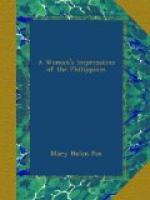I did my best to converse intelligently with the Gobernadora and the other ladies who were within conversational distance. A band came up outside and played “Just One Girl,” and presently one of the ladies of the house invited the Governor’s wife and me to partake of sweets. We went out to the dining-room, where a table was laid with snow-white cloth, and prettily decorated with flowers and with crystal dishes containing goodies.
There were, first of all, meringues, which we call French kisses, the favorite sweet here. There was also flaon, which we would call baked custard. In the absence of ovens they do not bake it, but they boil it in a mould like an ice-cream brick. They line the mould with caramel, and the custard comes out golden brown, smooth as satin, and delicately flavored with the caramel. Then there was nata, which is like boiled custard unboiled, and there were all sorts of crystallized fruits—pineapple, lemon, orange, and citron, together with that peculiar one they call santol. There were also the transparent, jelly-like seeds of the nipa palm, boiled in syrup till they looked like magnified balls of sago or tapioca.
I partook of these rich delicacies, though my soul was hungering for a piece of broiled steak, and I accepted a glass of muscatel, which is the accepted ladies’ wine here. My hostesses were eager that I should try all kinds of foods, and a refusal to accept met with a protest, “Otra clase, otra clase.” Then the Gobernadora and I went back to the sala, and another group took our places at the refreshment table.
I was much interested in the babies, who were strutting about in their finest raiment and were unquestionably annoyed at its restrictions. Filipino babies are sharp-eyed, black-polled, attractive little creatures. Whether of high or low degree, their ordinary dress is adapted to the climate, and consists usually of a single low-necked garment, which drapes itself picturesquely across the shoulders like the cloaks of Louis the Fourteenth’s time seen on the stage.




